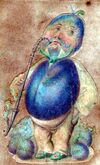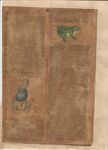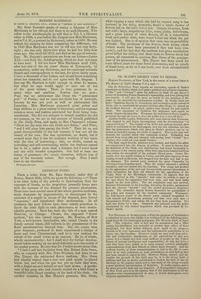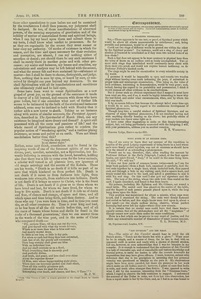Dr. Slade's Resent Visit to Berlin
Madame Blavatsky, of New York, in the course of a recent letter to The Banner of Light (Boston, U.S.), says:—
The St. Petersburg News reports an interesting episode of Slade’s experience at Berlin, which is of quite a political and religious character. “Allie” and “Owasso” were the indirect (or shall we say direct?) means of disturbing Prince Bismarck’s equanimity, and even getting him into trouble. I will give the story as nearly in the language of the paper as the necessity for condensation permits. In Berlin there are more “Spiritists than in St. Petersburg, and no wonder, as the arrival of Slade, who is considered the greatest medium after Home (?), stirred up the liveliest interest. As usual, parties were formed for and against Slade. The opponents of Spiritism felt indignant, and—again as usual—began exposing him. Hermann, the well-known Berlin juggler, promised through the press to show the public how it was all done.
Another Berlin juggler, Bellachini, still more famous than Hermann, then stepped in and began investigating, with the determination “to expose the fraud.” The inquiry of the latter was quite protracted, after which he published in the daily papers, over his own signature, the fact that the phenomena which take place in Slade’s presence can by no means be included among the tricks of jugglery. The reader may well imagine the scandal which this confession created. Bellachini was abused from every side, and charged with having been “fooled” by a Yankee, who could not even speak German.
The fight raged fiercely, passions were excited, and finally the affair was transplanted into the domain of politics. It must be known that the defenders of Dr. Slade and Spiritualism had found hospitality in the columns of the clerical party, while their opponents bombarded them from within the stronghold of the national liberal press. Prince Bismarck, who was quietly resting at Varzin, and felt quite innocent of any leading toward mediumism, was dragged into the fight and had to pay the damages. The clerical party pestered the great Chancellor by reviving a long-forgotten story. Thus the matter assumed a political character, and was carried into the Landtag. The clergy had profited by the appearance of the new and incontestably genuine phenomena to claim recognition for their old miracle for the appearance of the Virgin Mary in the Marningen community. It appears that the devout believers in this “miracle’’ had come in crowds to pray at the spot where the apparition had been seen, and had been badly treated by the local police. The old complaints were now revived. Minister Friedentahl, in the Landtag, defending the police, pronounced both the clerical ‘‘miracle” and the medial phenomena dangerous frauds. The clericalist deputy Bohsm demanded the punishment of the police and damages for the insulted community. Windsgorst. the well-known orator of the church party, claimed recognition for both miracle and phenomena, pointing out that even such men as Shopenhauer, Fichte, and others did not deny their possibility. The fight was lively for a time. Bismarck was annoyed and the public scandalised by this clerical impudence which was provoked by Dr. Slade’s spirits.

"Isis Unveiled" and the Todas
Sir,—The critic of Isis Unveiled should bear in mind the old Scotch motto, “Touch not the thistle but with a glove.” Wary must he be in attack, and a master of fence, for he has to deal with an opponent swift in action and ready with a shower of shrewd strokes. Let me, however, at once acknowledge that I was too brusque in my remarks. It is enough to understand that the authoress of Isis Unveiled is a lady of venerable age, and of remarkable and various knowledge and literary power, to make me hasten to offer the amende honorable for expressions that may have given offence. I must, however, submit with deference that she is too precipitate in assuming that her personal veracity was questioned so blankly as she puts it. My observations might have been more guarded, but there are passages in her work which make an old Indian marvel; however, I grant at once that India is wide, and truth often stranger than fiction. I. was spurred to write what I did by the nonsense emanating from the “Brahman Guru,” which I regret to observe the lady continues to support. I understood the account of the Todas to come, not from her own observation, but from a report made to her by the Guru, and, as I feel in no wise bound to keep measure with him, I must repeat, plainly and decisively, that he humbugged and misled the authoress.
In the first place, no “Guru of the Brahmans” has ever seen the Todas. They never leave their hills, and no Guru ever goes up there. To all Brahmans the hills are hateful and appalling; they cannot follow their observances respecting caste, food, and worship up there, and a sojourn on them is a severe and grievous trial. A Brahman official has occasionally very reluctantly gone up with the collector’s establishment for the yearly settlement, but no Brahman not so obliged, no free Brahman of note or sanctity, certainly no Guru.
During the last forty years the hills have become better known to the people of the plains below, and the agricultural, labouring, and trading classes have resorted there in large numbers to the markets, and for the employment afforded by the fast increasing European residents. The striking stature and personal appearance of the Todas, and their peculiar ways and customs, have hence become talked of in the district below, and exaggerated and foolish stories respecting them have spread far and wide. I think it probable enough, some Brahman pretender may have retailed such to the authoress of Isis Unveiled, for the accounts, as given by her, exhibit just the absurdities of popular gossip, every one of which the eyes of the informant would have set him right on had he seep the Todas himself; e.g., he is the authority for asserting that Toda women and Toda children are never seen, whereas, I, and all residents on the Nilgeris, have seen them by scores. Again, he asserts that they do not practise polyandry, whereas it is just as notorious and certain as polygamy in Salt Lake City; in fact, not to be tedious, I again assert, with Dr. Backie, that every statement made on the authority of the Guru is wholly inaccurate.
Neither will I admit that there is any secret which Lieut.-Colonel Marshall, Mr. Metz, Captains Harkness, Congreve, Ochterlony, and, I will add, myself, have not penetrated. We know all about and all beyond the dirty huts, munds, and temples of the aborigines—all about their customs, ceremonies, and worship, and affirm that there are no mystical secrets hidden behind; we testify that which we have seen and know, and when the authoress, who has not seen, cleaves to her Brahman, reaffirms his nonsense to be true, and refuses to retract a word, I can only lament it. The very notion of Mr. Metz, whom I knew well, being mistaken about the Todas, and this Guru right, is to all who have personal knowledge of the Nilgeris, their inhabitants, and Mr. Metz, so absurd as to be beneath reply; and I cannot but add that for any one who has no such personal knowledge, to term a book, carefully and laboriously written by one who had, “full of misconceptions,” argues, a strange amount of confidence. Captain O’Grady’s letter, communicated by Col. Olcott, gives a fair general account of the Todas’ habits, and certainly does not support the Guru.
In the lady’s letter in The Spiritualist of the 12th, there seems I rather a disposition to shift ground. It seems to be there hinted that the real Todas have moved away to unknown and inaccessible regions, and that those now to be seen on the Nilgiris are not the real mystical breed. And now I come to a point that puzzles me. Heretofore the authoress seemed to make no profession of having seen the Todas herself, but relied on the accounts of the Guru; but now she speaks as from personal knowledge, and writes, “Neither Captain O’Grady nor I recognised the individuals photographed in Colonel Marshall’s book as Todas. Those we saw wore their dark brown hair very long, and were much fairer than the Badagas, or any other Hindus.” Where did the lady see these people with long brown hair, and fairer than any Hindus? There are none such on the Nilgiris, where the Todas are certainly those photographed in Colonel Marshall’s book, and there are no other, Neither is there any unknown or inaccessible spot to which this mythical fair race can have betaken themselves. The Nilgiri hills are a triangular-shaped mountain mass, islanded amidst fertile plains, having the districts of Coimbatore and Malabar on their east, south, and west, and Mysore on the north, and their sides descend precipitously all round, They link on to no other mountain chain. The whole of their area has been surveyed and mapped out, and is thoroughly well known. There are no hollows, valleys, or recesses in which a tribe can be concealed. Too many, indeed, during the last five and twenty years have been invaded and laid bare by the ruthless coffee-planter, for where forest grows deepest coffee will flourish finest; but the forest must first be cleared. Many a fine sweep of forest, many a lovely wooded valley, have I seen denuded; and such has been the rage for coffee-chinchona, and latterly tea-planting, that the authoress may be assured there is no nook left unsearched. Every corner of the hills has been thoroughly explored, and there is no white Toda race on them, and no other Todas but those who have all been numbered, and all whose munds or villages are perfectly well known. The mountains nearest the Nilgiris are also well known, and there is no Toda race, white or brown, on any of them. It should be remembered that this part of India is not like the Himalayan regions, a vast, scarcely known, impenetrable country, containing valleys in which white races, like the mysterious Siaposh, may be concealed, We have heard of the shining city inhabited by a wonderful white people, the towers and domes of which are sometimes caught sight of far in the folds of the Cordilleras; and Mr. Stanley has just brought home authentic news of a white tribe even in Central Africa; but southern India is a limited, surveyed and mapped out tract, only 400 miles across from <... continues on page 7-98 >

Editor's notes
- ↑ Dr. Slade's Resent Visit to Berlin by Blavatsky, H. P., London Spiritualist, No. 295, April 19, 1878, p. 191
- ↑ image by unknown author
- ↑ "Isis Unveiled" and the Todas by unknown author (signed as Late Madras C. S.), London Spiritualist, No. 295, April 19, 1878, pp. 189-90
- ↑ image by unknown author
Sources
-
London Spiritualist, No. 295, April 19, 1878, p. 191
-
London Spiritualist, No. 295, April 19, 1878, pp. 189-90



